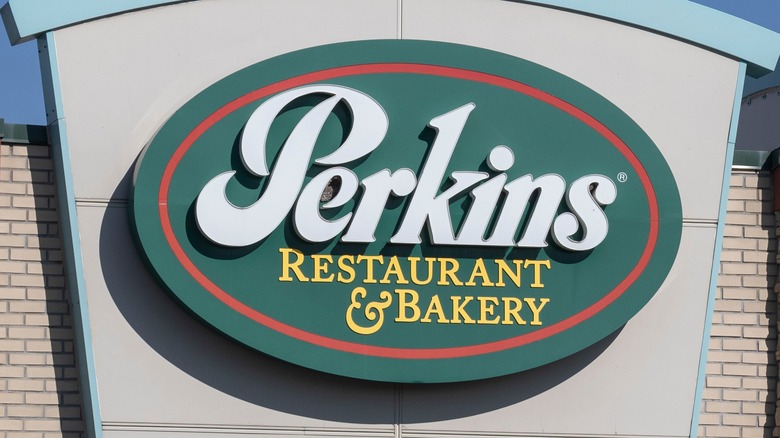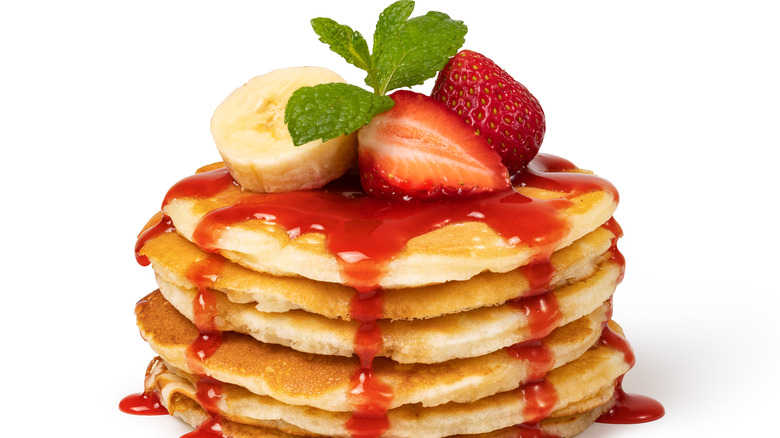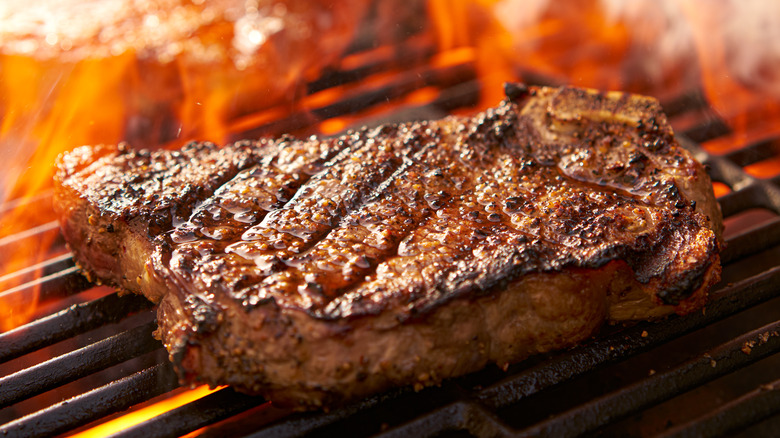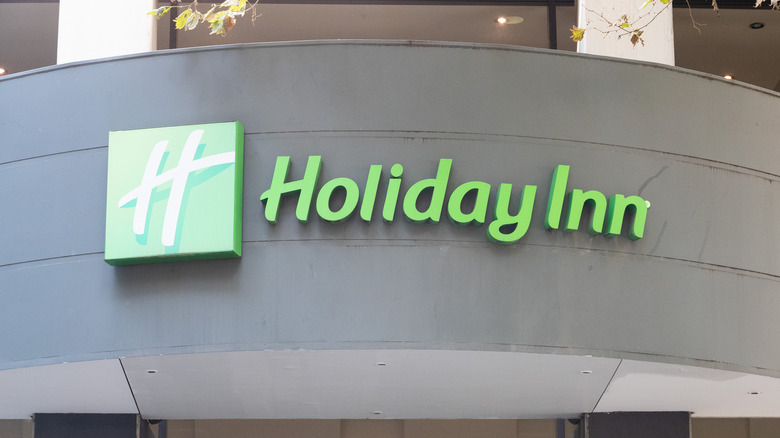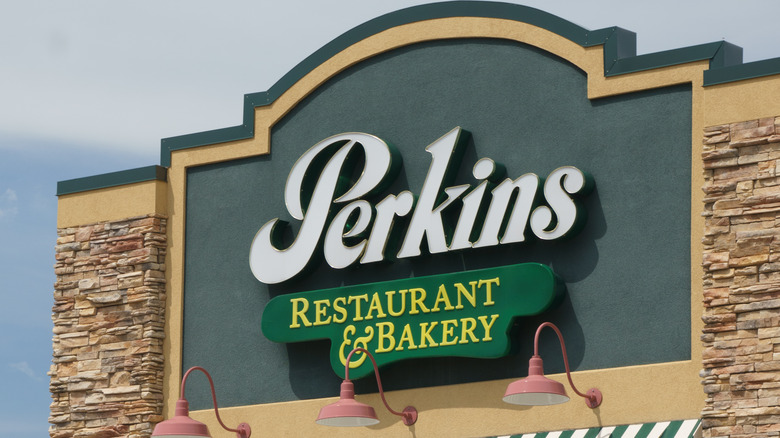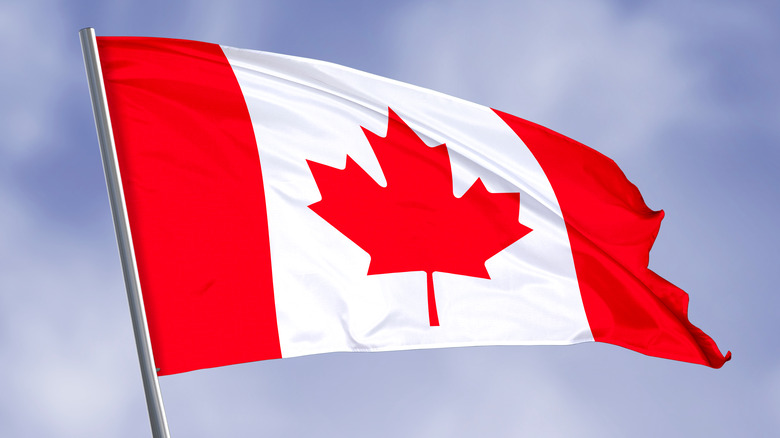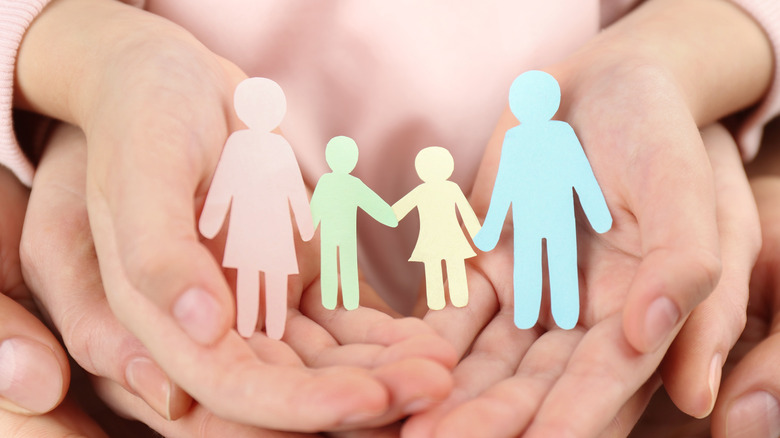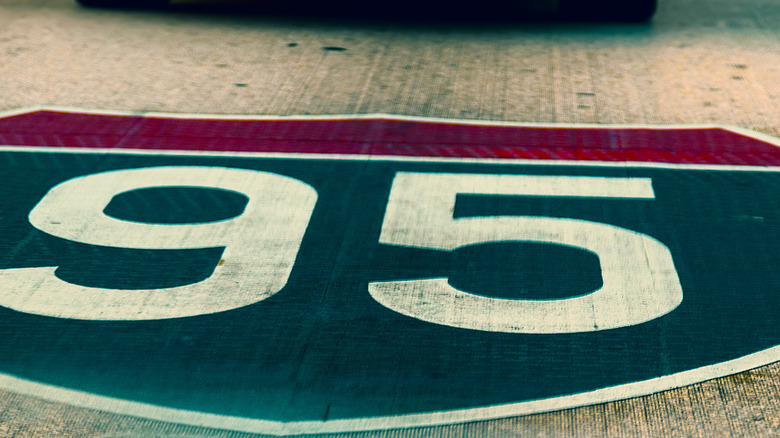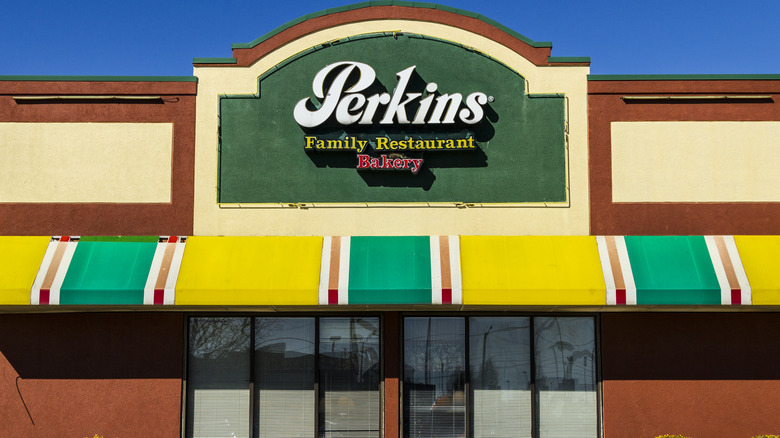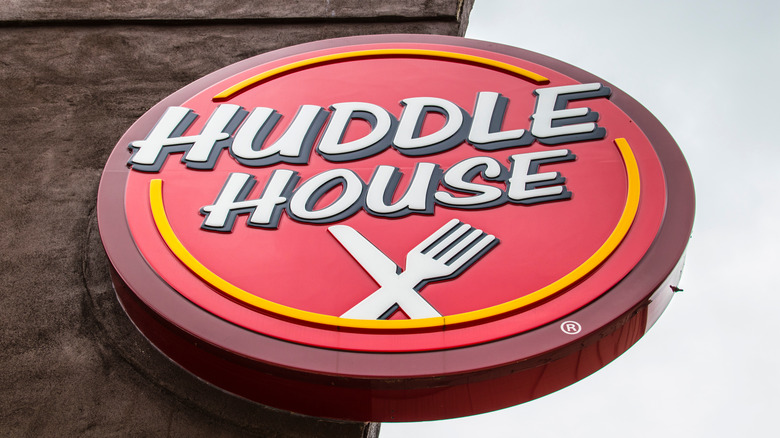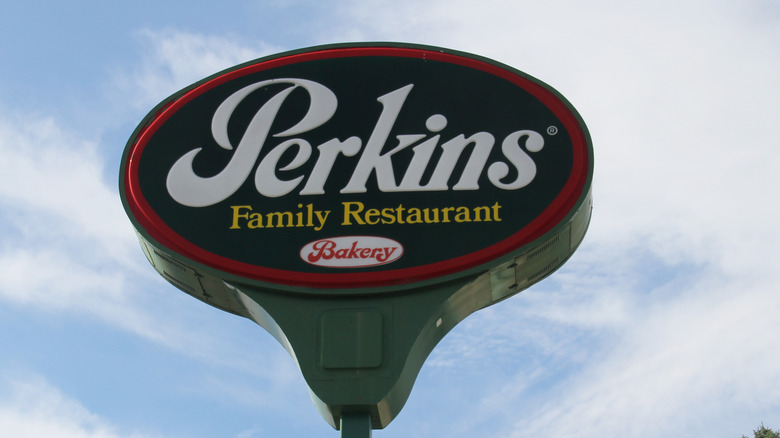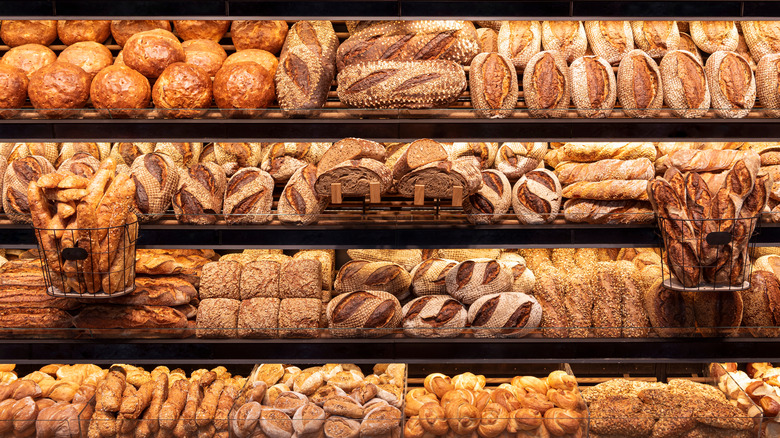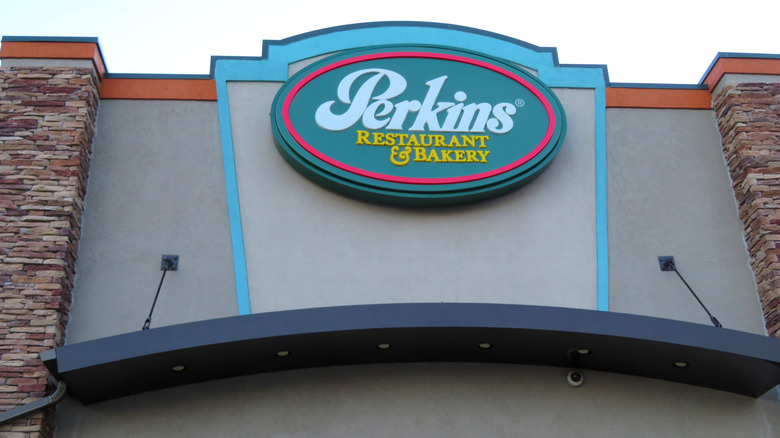The Untold Truth Of Perkins Restaurant And Bakery
Perkins has long satisfied picky eaters by doing more than just a little bit of everything. When you step inside a Perkins you quickly see this eatery brings the thunder to your hunger, with its menu going all-in on breakfast, lunch, dinner, and dessert.
This bevy of options has made Perkins a formidable family restaurant, a place where you can slide into a booth and not worry about what the kids will eat. With a cavernous menu rivaling The Cheesecake Factory's, the only pressing question is "what will you be having?"
As noted by Reuters, this restaurant chain has shouldered a few bruises to its bottom line. Nevertheless, this giant is still around, continuing to adapt to the landscape and accrue items on its menu. Part bakery, part coffee shop, part diner, Perkins is a resilient establishment that has pivoted through pitfalls since 1958, always managing to land on its feet.
Perkins started off as a pancake house
If you were to step into a Perkins kitchen in the late 1950s, you'd likely be inundated by waffle irons and pancake batter. There would be no bakery, and good luck finding a burger.
Originally dubbed "Perkins Pancake House," the initial iteration of the Perkins chain started off with a brown-and-orange logo and specialized in hotcakes. According to Perkins' website, the Perkins Pancake House offered two dozen varieties of pancakes, as well as waffles with an array of toppings. The restaurant still offers many breakfast options, but they occupy just a corner of their multi-page menu today.
Perkins Pancake House was successful, but like any growing company, they would soon branch out of their narrow lane. Thanks to an enterprising franchisee, they grew from a humble breakfast chain into something much more ambitious (via Funding Universe). Perkins' next big change would set the table for its nationwide expansion by opening its restaurants for lunch and dinner.
Then they changed their name to Perkins Cake and Steak
Perkins' identity as a jack-of-all-trades started taking hold in 1969 when Perkins Pancake House morphed into Perkins Cake and Steak, solidifying the fact that Perkins was about more than just breakfast.
The overhaul was the brainchild of Perkins franchisee Wyman Nelson, who began making aggressive and unilateral changes to his franchises in Minnesota in 1967. He put all his Perkins locations on a modern 24-hour, seven-day-a-week schedule. According to Funding Universe, Nelson's addition of a dinner menu is what led him to change the name of his franchises to Perkins Cake and Steak. He also recognized that the chain's loose-knit, informal network of franchises was holding it back, and aggressively consolidated the Perkins brand in the '60s and '70s.
It was clear that Perkins was capable of diversifying their offerings successfully. Nelson laid the stage for Perkins' current identity as an all-purpose, all-day restaurant.
Perkins was purchased by Holiday Inn's parent company
Perkins' corporate history is a merry-go-round of acquisitions, mergers, bankruptcies, and restructuring. But in the beginning, they were a strident enterprise charting for growth, and the owners of a popular family hotel chain were eager to invest in that future.
By the late 1970s, Holiday Corp., the owners of Holiday Inn, decided to acquire Perkins Cake and Steak. According to Funding Universe, Holiday Corp. was looking to expand beyond hotels and throw its capital into restaurants and casinos. While Perkins remained profitable under Holiday Corp.'s ownership, it never thrived during its time as a Holiday Inn subsidiary. A Holiday Corp. board member decided to fix the situation by making a bold move and taking Perkins private. He made many changes to the brand, including revamping the chain's dated decor. This shakeup would prove to keep Perkins relevant, as growth and revenue had stagnated throughout the 1980s.
Perkins in-house bakery wouldn't arrive until the 1980s
Imagining Perkins without a bakery is a tough sell for those of us who've already fallen in love with their Mammoth Muffins. For those who haven't been, there really is nothing like Perkins' dessert counter of temptation. It's hard not to be drawn by the allure of all those decadent pies under the glass cover. You can even skip dinner and just buy pies to take home, as Perkins offers whole pies to go.
These days, the world of Perkins revolves around its bakery. Ironically enough, the chain's iconic bakery didn't exist until Ronald Reagan was in office, almost 30 years after the first Perkins opened for business. According to Perkins, the in-store bakeshop debuted in 1986.
Perkins quickly understood the power of the pastry, eventually adding 'Bakery' to its name. Today, a Perkins without the pie smell just doesn't seem possible.
Perkins expanded into Canada in 1988
Armed with a bakery and keeping an eye out for expansion opportunities, Perkins crossed into the Canadian frontier in 1988, setting their stakes down in Thunder Bay, Ontario (via Zippia). And interestingly enough, the first Canadian Perkins would be located just six miles across the water from Pie Island.
Coincidence? Most likely. It proved to be a good omen, however, as Perkins continues to exist in Canada. Perhaps its most prominent location north of the border is the Niagara Falls outpost, which sits just one block from the Falls' viewing area. In an acknowledgment of the chain's cross-border footprint, the Niagara Falls location calls its pancakes not just the best in the U.S., but "the best in North America." That's a bold claim!
Although Perkins has weathered some financial storms, several Perkins locations remain in Canada today, including their Thunder Bay and Niagara Falls locations.
Perkins has supported Give Kids The World Village for over 30 years
Perkins' dynamic offerings include their strong push into philanthropy. Starting in 1989, Perkins teamed up with Give Kids The World Village — a nonprofit attraction in Kissimmee, Florida designed to bring joy to critically ill children through a theme-park atmosphere. Providing a sprawling and fantastical candy-coated world where kids can explore vivid venues such as the House of Hearts, Marc's Dino Putt, and Julie's Safari Theatre (via Give Kids The World).
Give Kids The World Village started off in 1986, and through corporate partnerships such as Perkins, it has blossomed into an 89-acre resort with 166 villas. The village is a feel-good and growing initiative that has welcomed guests from the United States as well as abroad, having entertained families from 76 countries.
In addition to its monetary benevolence, Perkins has hands-on involvement within the village, cooking up its wares at Nancy's Kitchen in Café Clayton.
Perkins focused on expansion in the '90s with their I-95 Strategy
The 1990s was a boom time for Perkins and they were looking to grow their opportunities for profit. Their CEO at the time, Donald Smith, had improved Perkins' bottom line in the '80s. He decided to use the added funds for aggressive expansion.
Smith decided to focus on the population-dense corridor around Interstate 95 on the East coast. According to Funding Universe, Smith had wanted to double the number Perkins' locations by halfway through the decade. The company accomplished its expansion goals by focusing on franchising rather than opening more company-owned locations.
As Smith envisioned, Perkins grew quickly. Sales grew by 40 percent, but it was mostly a direct product of expansion, as the chain's profits suffered during the period of expansion. Even worse, the rapid additions had a chaotic effect on Perkins' stock price, which fluctuated throughout the '90s and served as a harbinger for future financial turbulence.
Perkins filed for bankruptcy in 2011 and again in 2019
Perkins trudged along and put on a brave face for survival, but the chain was in trouble. According to Reuters, in 2011 Perkins' parent company had to close 65 Perkins and Marie Callender's restaurants and turn over the reins to their creditors. The legacy of its unwise expansion efforts proved hard to shake. In 2005, Perkins acquired Marie Callender's restaurant company for $140 million, a subsidiary that did nothing to improve the company's fortunes.
Like all nuanced problems, however, there were myriad reasons that such a Goliath of chains ended up financially insolvent. Joseph Trungale, Marie Callender's president, attributed Perkins' troubles to the mid-2000s housing crash and accompanying recession.
Sometimes timing is everything, and everything seemed to be hitting Perkins right where they expanded. After reshuffling and reorganizing through 2011's fiasco, Perkins & Marie Callender's would file for bankruptcy again in 2019 (via USA Today). Perkins would recover, but they'd have to prove their resilience again through a new corporate benefactor.
They were acquired by Huddle House
Shortly following its second bankruptcy, Perkins was scooped up by Huddle House, a restaurant chain headquartered in Atlanta, Georgia.
Boasting an independent supply chain, in 2020 Huddle House sought to rehabilitate Perkins in the belief that their powers could combine into an expanded market share. Huddle House was well-known down in the Southeast, and the company hoped to broaden its reach with the Perkins acquisition, as Perkins has more name recognition outside of that region.
Huddle House believed in the opportunity of installing Perkins within hotel locations, positioning the restaurant as an ideal addition for hotel owners and other businesspeople. The company told USA Today that while they would operate Perkins from their headquarters in Atlanta, they would keep the two brands separate from each other. A third bankruptcy would not be charming, but it appears this time Perkins may have found the perfect partner in Huddle House, whose "Any Meal, Any Time" slogan fits well with Perkins.
Perkins added pickup windows in response to the COVID-19 pandemic
Perkins' voyage through rough waters would not end in 2019, as the COVID-19 pandemic swept the world the next year, changing it in the process.
The future of the world was uncertain and so was the return of indoor family dining, so once again Perkins would have to pivot in order to profit. Having been battle-tested by two bankruptcies, Perkins was prepared to face a challenge. This was a problem that faced everyone in the restaurant industry, and it would require Perkins to change its outlook entirely.
CEO of Huddle House, Michael Abt, decided to position Perkins for the future by setting them up for delivery (via the Franchise Times). New Perkins locations would come equipped with pickup windows and delivery driver waiting areas. In addition to the pandemic-related innovations, Abt has also entertained the idea of bringing Perkins into universities, hospitals, and military bases.
They launched a virtual bakery
Perkins didn't stay in the shadow of bankruptcy for long. In response to the pandemic and the increased popularity of delivery services, Perkins pivoted into the virtual kitchen space with Bakery by Perkins in 2021 (via Restaurant Dive). The new venture is a kitchen-only online space that delivers all your favorites from Perkins' baked goods chapter of the menu, bringing Mammoth Muffins, homestyle apple pies, and more at your door with a few taps of your device.
According to Restaurant Dive, Perkins is aiming to provide this service at all of its locations by the end of 2021 as baked goods are their best sellers during the Holiday season.
So far early signs are pointing to success. When Perkins rolled out its virtual bakery in 17 test locations throughout Florida and Minnesota, sales of baked goods saw increases of up to 20%. Given the success of other classic restaurants going virtual, it appears Perkins has found yet another niche to gain a foothold.
Perkins' menu features over 100 items
Under the big green roof of Perkins, the food options know no boundaries. It's truly an understatement to say Perkins' menu is gigantic. Armed with over 100 items, trying to sample everything on offer requires discipline and dedication.
From their simple beginnings, Perkins has become a kind of anthology of a restaurant, adding more chapters to its menu with each passing decade. First it was pancakes and waffles, then it was lunch and dinner, and finally, a bakery. Their menu serves as a historical document, recording each time the brand expands its offerings.
Their online menu starts on the classics and the journey only grows more delicious on the scroll down. From omelettes and eggs Benedict to burgers, sandwiches, and savory skillets, this massive menu doesn't quit until you've made a final decision. The baked goods can be found near the bottom of this bountiful document, tempting you with even more food when your stomach is already full.
